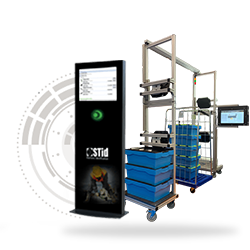A little history…
ATA SPEC 2000 is an international standard created by the Air Transport Association (ATA) in order to optimize exchanges, communications and information flows within the aeronautics industry.
The purpose of the standard is to provide a structure, a method and rules that are common for writing, storing and reading data for all the stakeholders in the aeronautical supply chain.
This standard implies being able, among other things, to precisely and individually identify each part (industrial asset) to ensure reliable follow-up. This traceability makes it possible to visualize, extract, communicate, modify and complete the global history of each asset (date of creation of the part, its characteristics, its life cycle, its maintenance etc.).
Each asset is identified by its unique reference number. In the past, this reference number was manually recorded by visual inspection or 2D barcode. The reference number is now formatted according to the ATA SPEC 2000 specification, allowing it to be read and understood by all the stakeholders in the aeronautics industry.
This common specification within the sector streamlines and automates the reading, writing and exchange of information.


RFID in an industrial environment
RFID (Radio Frequency Identification) contactless identification technology has replaced the use of barcodes in many industrial and logistics traceability applications. This is very well illustrated by the aeronautics industry. The ATA SPEC 2000 specification includes an entire chapter on RFID (Chapter 9.5 + Appendix 11: "Automated Identification and Data Capture"). The use of RFID technology is a major asset in the optimization and streamlining of aeronautical processes, including MRO (Maintenance, Repair and Overhaul): The identification process requires no visual contact with the part to be identified, which is not the case of manual reading or barcode techniques.
For example, RFID contactless identification can be used to identify an engine part without having to dismount it of the engine in order to access the identification information. The RFID identifier (Tag), unlike the barcode identifier, has a memory. This makes it possible to inject information directly into the tag once installed and modify this information over time without changing the support. For example, it is possible to read and write data in a tag without having to consult a database. A motor part is not only identified by a unique reference number. With RFID, thanks to the tag allocated to it, the part can take up all the data related to its nature, characteristics, functionalities, life-cycle - and its MRO information.
RFID and ATA SPEC 2000 compliance
The ATA SPEC 2000 is a data characterization standard used in aeronautics while RFID technology is a means of writing and reading data; compliance of the RFID tools is therefore required. The standardization of data is specified in Chapter 9.5 and Appendix 11 of the reference document.
For example, the memory of an RFID identifier must be structured (memory mapping according to the ATA SPEC 2000 specification) so that it can be encoded and receive the information about the identity of the part and its history. The EPC (Electronic Product Code) unique identifier and the User Memory of the tag can then be specially encoded.
Similarly, an RFID reader, portable or fixed, must integrate firmware or software compliant with the specification of this international standard in order to read or write information in ATA SPEC 2000 format in an RFID tag.

 |
ATA SPEC 2000 expertise from STidOnly a recognized expert in RFID and ATA SPEC 2000 can implement RFID traceability solutions in the aeronautics industry. STid has that dual expertise, thanks to more than 10 years of working jointly with Airbus and Safran. We are behind the first embedded RFID solutions within aircraft, used to optimize, ensure the reliability and secure the maintenance processes (MRO) of helicopter parts and aircraft engines. |
STid today is a benchmark in the use of the ATA SPEC 2000 standard applied to RFID technology and its different business applications. We offer a wide range of UHF tags and RFID readers / encoders specifically designed for MRO applications that are ATA SPEC 2000 compliant.
We have developed a complete library of ATA SPEC 2000 commands (Windows- and Android-compatible SDK), thus allowing us to provide global hardware and software solutions that meet the international standard. As an RFID and ATA SPEC 2000 expert, we also offer comprehensive training on the use and implementation of this standard in your industries. You thus benefit from a single point of contact for the implementation of ATA SPEC 2000 MRO solutions.
The future of the ATA SPEC 2000
Historically created by and for the aeronautics industry, the ATA SPEC 2000 standard is today considered the most complete and efficient data characterization system in any sector.
Since its commissioning 40 years ago, this international standard has proved its operational efficiency and enabled the optimization of business processes, the streamlining of commercial exchanges and the rationalization of management costs in the aeronautics industry.
These results have incited other sectors and industries to focus on the ATA SPEC 2000.
For example, the French Army as well as the naval and rail industry are all beginning to integrate this standard, particularly for MRO and traceability applications (weapons, intervention equipment, axles, etc.).
STid is specialized in the severe environmental conditions of these industries. We provide the highest levels of expertise, and solutions tailored to your regulatory and functional constraints, for all your projects involving industrial traceability, MRO and the migration of your IS (Information System) to the ATA SPEC 2000 standard.













